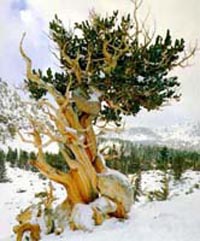Resource Library
Plant of the Week: Pine, Bristlecone
The University of Arkansas System Division of Agriculture does not promote, support or recommend plants featured in "Plant of the Week." Please consult your local Extension office for plants suitable for your region.
Plant of the Week
Bristlecone Pine
Latin: Pinus aristata

As the millennium approaches, we should discuss a plant that can easily reach a 1,000 years old. In fact, amongst the bristlecone pines, a 1,000-year-old tree is still considered a seedling.
This small five-needle pine is one of the oldest living things on earth with numerous documented cases of trees reaching 4,000 years old. Some of the oldest are suspected of being 7,000 years old.
Bristlecone pines, as landscape plants, fit into the general category of being more interesting than beautiful. The trees are native to our western mountains ranging from New Mexico and Colorado westward to the mountains on the California-Nevada border. Because they are so slow growing, they usually only reach heights of 20 to 25 feet with an open, irregular form. But you must consider that the oldest planted trees are only 140 years old, so they may get bigger given time.
The needles of this pine are in clusters of five with a blue-green coloration which is sometimes coated with a white wax which gives them that bluish look of several of our western trees. The needles persist from 14 to 17 years at the ends of the branches and are held close to the limb giving the pine a common name of "foxtail" pine.
In theory at least, all trees should be able to attain the tremendous age of these gnarled specimens, but none do. Bristlecone pines live to such great age due to a combination of factors. First they grow in rocky, dry remote sites where environmental conditions simply do not permit fast growth. Fast growth -- and large size -- can create problems with the laws of physics as really old trees sometimes topple because of their own weight. The saturated soil and wind we had about 10 years ago brought down one of Dardanelle’s 350-year-old Council Oaks.
The sites are so inhospitable that fungus diseases and insects that might torment pines in better locations are less successful in these extreme sites. While the jury is still out on the fate of planted trees, most experts feel that they will never attain really old age in landscape sites.
Lastly these trees have attained ancient stature because they are of no use to man. These gnarled, twisted trees just don’t make good 2 x 4s. In fact, Nevada’s Great Basin National Park was created as a direct result of a U.S. Forest Service decision to cut down a 4,900-year-old tree in a stand of ancient trees to give as favors at one of their meetings.
In Arkansas, 350-year-old oaks are fairly common, but they are always found along rocky ridges and have always been too small and stunted to bother cutting.
Bristlecone pines are in the nursery trade but they are only suited to the mountainous parts of the state. They are incredibly slow growing, with a 14-year-old tree only being 4 feet tall. This makes them ideal for use in a rock garden or even containers but somewhat limits their use as shade trees. They will tolerate poor, rock alkaline or acidic soils but should not be planted in soils with high clay content and poor drainage. They must have full sun.
By: Gerald Klingaman, retired
Extension Horticulturist - Ornamentals
Extension News - December 17, 1999
The University of Arkansas System Division of Agriculture does not maintain lists of retail outlets where these plants can be purchased. Please check your local nursery or other retail outlets to ask about the availability of these plants for your growing area.